This piece is Part One of a two-part series featuring the YMCA of the North.
Part Two: Tackling Systemic Change with OKRs
When people think of the YMCA, the image that comes to mind is likely a combination of fitness centers and youth hostels.
In some ways, this is a long way from what the organization was founded to do — to help young men in Industrial-era London seek refuge from “the hazards of life on the street.” Since its inception in 1844, the organization and its many chapters around the globe have gone through several rebrandings. The most notable one being a 2010 revamp that led people to call them “The Y.”
Now, the second largest YMCA in the US is undergoing another major transformation. YMCA of the North, formerly called YMCA of the Greater Twin Cities, is determined to shed its “swim and gym” image and become known as a community-oriented holistic health and well-being institution. Glen Gunderson, the Y’s President who boasted a long career in the for-profit health and fitness industry before joining the nonprofit, is at the helm of that transformation. One of the tools that Gunderson has turned to carry out the transformation, is Objectives and Key Results (OKRs).
Getting back to YMCA’s roots
The pandemic marked a major turning point in the Y’s business. Over the last 40 years, the organization had landed “on this revenue model that was really swim and gym intensive,” said Gunderson. “It was a commodity.” That revenue source disappeared when people were forced to stay in their homes. 2020 also highlighted the importance of community, particularly in Minnesota. Being located at the epicenter of the social reckoning in the aftermath of George Floyd’s murder forced the Y to step back and see how it might serve its community in the best possible way.
Gunderson was aware that the image of the Y was far from a “progressive game-changer.” He was determined to change that perception. In a way, they wanted to go back to their roots, “taking the historical elements of the Y: spirit, mind, and body” and integrating that programming into services for a broader audience. When COVID-19 hit, he observed the exacerbation of mental health issues that has plagued so many Americans. “It was clear we needed to get beyond fitness and go to a whole person perspective,” he says.
When you think about holistic well-being, Gunderson says, those services tend to be only accessible in areas where there is premium high-end retail. So the first step is figuring out how to introduce them in communities that don’t have access to them without compromising on quality.
Gunderson realized that many inner-city youth don’t often have access to these kinds of experiences and are missing out on the benefits. “Being out on a trail, being engaged in nature — these are healing experiences.”
That’s why the organization partnered with philanthropists Bill and Penny George, who had launched a well-being center just before the pandemic. They quickly realized it wasn’t enough to have a center, and incorporated virtual programming as well as nature and outdoor activities. “We’ve always had a historic strength around camps, but we’ve looked at camp in maybe too narrow a lens. We haven’t recognized the dynamics around social and emotional learning, character development, leadership development that happens at camp for all ages,” Gunderson said.

Introducing OKRs in the nonprofit world
Moving away from a swim and gym model also made financial sense for the Y, by diversifying their sources of revenue. However, being a community-focused nonprofit, the organization needed to balance short-term results with creating long-term systemic change.
Gunderson knew that achieving balance required the right tools. “It became clear that we were going to need to have a stronger platform to align our team members,” and to recognize progress and success.
After investigating various tools, platforms, and management approaches, executive vice president of strategy and innovation officer, Nathan Maehren, suggested using OKRs. They also enlisted Gracie Koester, an OKR consultant from Agile Strategies, to help with the transformation. Koester identified a critical success factor. “How do you make sure everyone in the organization feels the importance of their work, while also recognizing the importance of making this change?” she says.
Gunderson soon learned that the biggest challenge isn’t necessarily getting everyone excited about the new steps they were taking. It was to “stop doing things that weren’t going to help the organization necessarily transform.” Deciding to sunset something at the Y, says Gunderson, takes a “herculean effort. There’s this, what I call ‘benevolent quotient.’ That is, our heartstrings being tugged on and stretched by, you know, yes, we used to help 1000 people over here, and we only serve 10 families now, but hey, it’s still these three families that need us. If we weren’t there for them, who would be?”
“It takes on a different flavor than it does if you’re selling a chip at Intel,” Gunderson continues. “We needed a better capability and a better alignment of sorts for folks to recognize, ‘Wow!’ Transitioning away from those three families, we are in fact going to be more effective serving 1000 over here, based on the new innovation or the new program or product.”
Ensuring that the Y’s employees felt connected to that message meant that they also had to package OKRs in a way that felt true to the organization’s spirit, so Gunderson introduced the concept as “Mission, Objectives and Key Results” (MOKRs). It seemed like a small change, but Gunderson believes the nuance helped staff at the Y see it as a tool that wasn’t purely profit-driven.
The importance of streamlining
The next challenge for Gunderson was deciding on the Objectives and Key Results. At first, Gunderson and his team set five Objectives. Before using OKRs, the team wasn’t as bullish about eliminating priorities, and there was hesitation in abandoning projects. Gunderson recognized the value in the breadth of the mission, but he also realized that having too many focus areas would make it difficult for the organization to sustain and grow.
Koester remembers that discomfort, but the team soon had an “aha” moment. “We realized what the YMCA is trying to do is integrating the old and the new, and integrating equity and well-being into everything,” she says. “So, if that’s the goal, why would we have these five siloed MOKRs that spoke to these separate programmatic areas?” In the end, they streamlined the Objectives to just three MOKRs, “but it was three that looked at the integration of those things” Koester explains.
Gunderson found streamlining the MOKRs to be a freeing experience. Improving equity and well-being is “everybody’s job,” says Gunderson, “and our leaders need to be integrating their expectations in symbiotic concert with the rest of the organizations.”
This piece is Part One of a two-part series featuring the YMCA of the North.
Part Two: Tackling Systemic Change with OKRs





